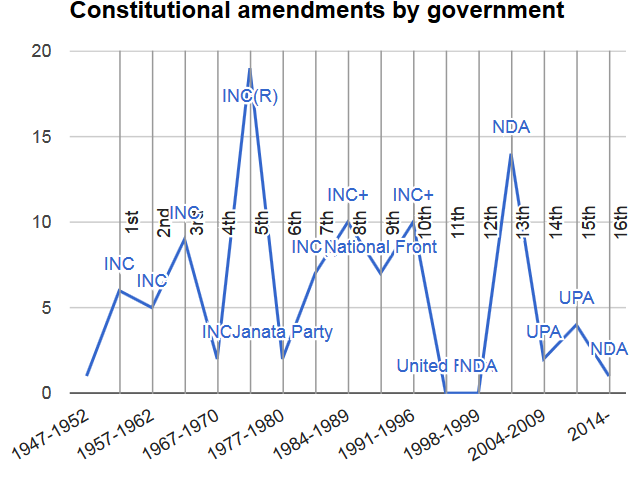The Constitution of India: Amendments

This article has been sourced from an authoritative, official After the formal launch of their online archival encyclopædia, |
The power to amend the Constitution
Article 368 of the Constitution of India gives Parliament the power to amend the Constitution, through a procedure described by Dr. B.R. Ambedkar in the Constituent Assembly as one of the simplest in the world. For a Bill seeking to amend the Constitution to pass, it must secure a majority of the total membership of the House and a majority of not less than two-thirds of the members present and voting, in each House of Parliament. Some special cases — amendments that affect the functioning of State governments, High Courts or the Supreme Court for example — also require the ratification of half the State legislatures in the country.
The most fundamentally transformative amendments
What are some of the most fundamentally transformative amendments that India’s Constitution has seen over the years? Rukmini S of The Hindu asked Alok Prasanna Kumar, Senior Fellow at the Vidhi Centre for Legal Policy for his opinion, and here are his Top 10.
1951: 1st Constitutional Amendment
Imposed restrictions on freedom of speech, allowed reservations in schools and government jobs, and prevented challenges to land reform laws by creating the 9th Schedule. Most of the amendments were introduced after High Courts had struck down laws of state legislatures restricting freedom of speech, providing reservations and introducing land reform.
1956: 7th Constitutional Amendment
Following the demand for linguistic states, this Amendment radically altered boundaries of the existing States on linguistic and ethnic lines following the report of the First States Reorganization Commission (the Fazl Ali Commission) and agitations which preceded that
1971: 26th Constitutional Amendment
Part of Patel’s mammoth task of unifying India’s princely kingdoms, large and small, was the promise of a “privy purse” in lieu of the enormous revenues that the princes enjoyed from their kingdoms. First abolished by ordinance, which was struck down by the Supreme Court and then abolished once again by Amendment.
1975: 39th Constitutional Amendment
The only amendment that has so far been passed with the sole intent of protecting one person: Indira Gandhi, whose election had been annulled by the Allahabad High Court. This was struck down by the Supreme Court while, ironically setting aside the Allahabad High Court judgment annulling her election.
1977: 42th Constitutional Amendment
Indira Gandhi’s Government virtually re-wrote large parts of the Constitution taking away judicial review, amending the preamble to add the words “socialist” and “secular”, cutting deep into judicial independence and significantly reducing Fundamental Rights protections among many other amendments. By far the most extensive amendment to the Constitution virtually creating a brand new Constitution.
1978: 44th Constitutional Amendment
The Amendment introduced by the Janata Government primarily to undo the ills of the 42nd Amendment Act, after a few changes were initially made by the the 43rd Amendment Act. It restored the independence of the judiciary, the enforceability of fundamental rights and judicial review, but crucially did not re-introduce the right to property as a fundamental right, preferring to protect it as a constitutional right.
1985: 52th Constitutional Amendment
To curb growing instances of horse trading and defections, the tenth schedule was introduced in the Constitution disqualifying MLAs/MPs who defected from their party either by loss of membership or through voting.
1989: 61st Constitutional Amendment
Reduced the voting age from 21 to 18 opening up the franchise to a large section of the population.
1992: 73rd & 74th Constitutional Amendments
Though ostensibly two separate amendments, they are often seen as part of one unified attempt to try and fulfil Gandhi’s dream of devolution of power to the lowest units of governance: the Panchayats.
2002: 86th Constitutional Amendment
Right to Education was first introduced as an enforceable Fundamental Right where earlier it had been a non-enforceable Directive Principle of State Policy.
Highest number of amendments
Indira Gandhi’s government from 1971 to 1977, which included the Emergency years, passed the most Constitutional amendments (19). The next highest number was under the Atal Bihari Vajpayee government (14).
Struck down by the Supreme Court
Only five constitutional amendments have ever been struck down by the Supreme Court, according to analysis by the Vidhi Centre for Legal Policy:
Kesavananda Bharati v State of Kerala (1973) which struck down part of the 25th Amendment for taking away judicial review of land reform laws;
Indira Gandhi v Raj Narain (1975) which struck down part of the 39th Amendment for taking away judicial review of elections of the PM and Speaker;
Minerva Mills v Union of India (1980) which struck down parts of the 42nd Amendment for making Directive Principles superior to Fundamental Rights and for removing judicial review over amendments to the Constitution;
P Sambamurthy v State of Andhra Pradesh (1987) which struck down part of the 32nd Amendment for permitting the Government of Andhra Pradesh to modify or change orders of Administrative Tribunals before it decides to implement them; and
L Chandra Kumar v Union of India (1994) which struck down part of the 42nd Amendment for taking away the power of the High Court to review judgments of tribunals.
See also
The Constitution of India (articles about) <> The Constitution of India: Amendments<> The Constitution of India: Amendments 1-25<> The Constitution of India: Amendments 26-50<> The Constitution of India: Amendments 51-75<> The Constitution of India: Amendments 76-100